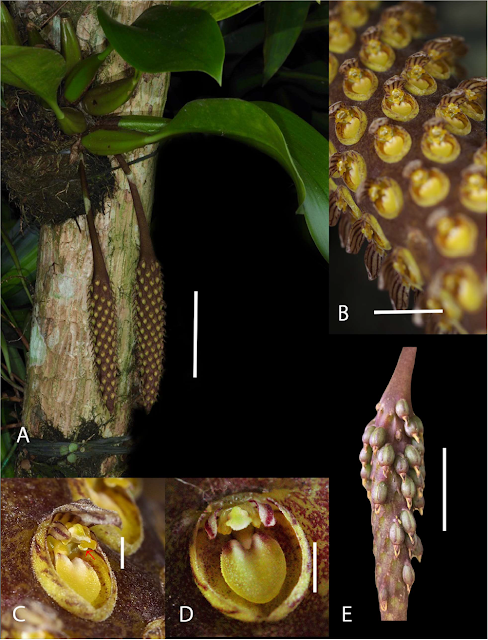Epidendroid Orchids, Epidendroideae, are the largest subfamily of Orchids, with over 15 000 described species, more than all other Orchid groups combined. The majority of these species are epiphytic (live on other plants, typically in the canopy of rainforest trees), though terrestrial forms are known. The group is found across the globe, with the exception of the polar regions, the deserts of Africa, Arabia and Australia, and the southern part of South America. The genus Bulbophyllum contains around 2200 described species from tropical regions around the world, including about 1600 species from Asia, and is thought likely to contain many more undescribed species. Members of the genus can be very difficult to tell apart when they are not in flower, as their vegetative parts tend to be much reduced, often with only a single leaf emerging from a pseudobulb (a pseudobulb, like a bulb, is an enlarged stem base used as a food store by a plant during dormant periods, but unlike a bulb is not found in the soil).
In a paper published in the journal Taiwania on 10 January 2022, Aninda Retno Utami Wibowo of the Bali Botanic Garden of the Indonesian National Research and Innovation Agency, Jeffrey Champion of the Herbarium Bogoriense of the Indonesian National Research and Innovation Agency, and Lina Susanti Juswara of Candikuning, Bali, describe a new species of Bulbophyllum from Sulawesi.
The new species is named Bulbophyllum mamasaense, where 'mamasaense' means 'from Mamasa' in reference to the Mamasa Regency of West Sulawesi Province, where the species was discovered. Only a single wild population of the species has been discovered, in Mesawa District of Mamasa Regency, but the species appears to do well in cultivation, and has been traded commercially for some years.
Bulbophyllum mamasaense produces three distinct, closely arranged, ovate–oblong pseudobulbs (storage organs derived from a thickening of the part of a stem between leaf nodes) from a creeping rhizome, with smooth, wiry roots spreading below the pseudobulbs, and oblong leaves, 16-16.5 cm long and 5.3-5.5 cm wide above. Flowers are born on pendulous inflorescences arising from the base side of the pseudobulb. Each inflorescence can bear up to 165 flowers, densely packed in eight rows, which open similtaneously.
See also...



Follow Sciency Thoughts on Facebook.
Follow Sciency Thoughts on Twitter.





